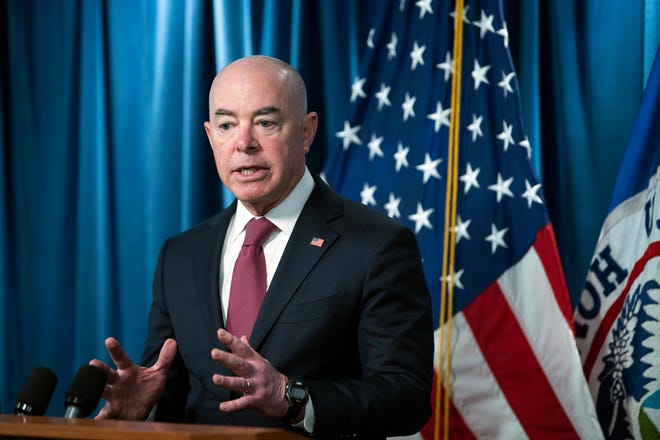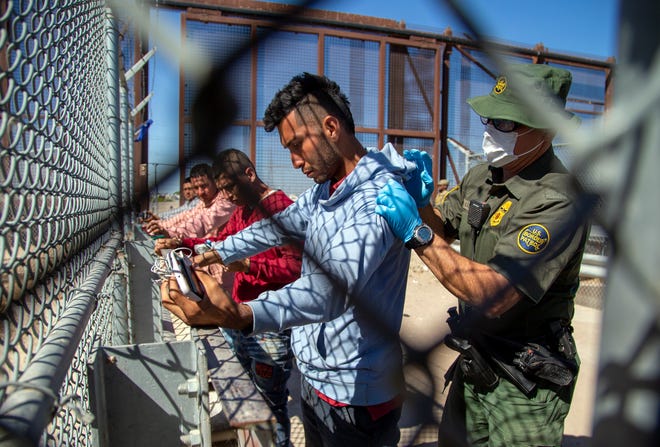Shelters? Troops? The latest efforts to fix the border crisis before Title 42 ends.
President Joe Biden warned this week that the southern border would “chaotic for awhile” after a 3-year-old pandemic-era immigration law lifts Thursday.
But the chaos is already here.
More than two years after Biden started a court battle to end Title 42 − a law that has kept thousands of migrants out of the country − the border is at an inflection point. The administration, despite criticism from its own party of a perceived lack of preparation and three months of lead time into Title 42’s expiration, doubled down Wednesday in defense of its plan to solve the complex border crisis.
“Even after nearly two years of preparation, we expect to see large numbers of encounters at our southern border in the days and weeks after May 11," Homeland Security Secretary Alejandro Mayorkas said. "Our plan will deliver results, but it will take time for those results to be fully realized. And it is essential that we all take this into account.”
Hundreds of migrants turned themselves in for immigration processing in El Paso, Texas, after learning federal authorities would begin “targeted enforcement" to round them up. States are taking the crisis into their own hands, with a combination of militaristic and humanitarian methods. And the first waves in a group of 1,500 military service members with the Army and Marines were due to arrive Wednesday.
Without proper documents, migrant families have been sleeping on cardboard and under makeshift lean-tos, unable to travel. Record numbers of Cuban, Venezuelan and Central American migrants are crossing the border illegally. All the while, the governor of Texas has been mobilizing a tactical border force to intercept migrants.
“I travel to Arizona and west Texas, and recently have been to south Texas,” said Tony Payan, a professor at Rice University in Houston. “Wherever I go, migrants just keep going, and I think the Biden administration just doesn’t know what to do.”

'Targeted enforcement' leads to confusion in El Paso
In El Paso, a haven for migrants long before the formal expiration of Title 42, migrants were navigating a threat of "targeted enforcement" from U.S. Customs and Border Protection and U.S. Immigration and Customs Enforcement, the only community to report such a situation to the USA TODAY Network.
More than 3,300 migrants, many of whom crossed the U.S. border illegally, had set up camp as of Monday around a Catholic church in the downtown area and on the sidewalks outside a homeless shelter. There were hundreds of men traveling alone but also many families living on the trash-strewn streets.
The federal enforcement operation had been scheduled to start Tuesday, immigration authorities said, but refugee advocates said they were confused about what was actually happening. By Wednesday, hundreds had turned themselves in to authorities, but advocates didn’t know if migrants would be afforded their legal right to seek asylum or summarily removed.
“The message keeps changing,” said Mark Seitz, bishop for the Catholic Diocese of El Paso. He pointed to an official communique from U.S. Customs and Border Protection on Monday night warning about expulsion and removal. By Tuesday morning, plainclothes officers were handing out a flyer that “just basically said, ‘You can go turn yourself in at the bridge.’ There were no assurances there either.”
Seitz spent the morning counseling migrants around one of his churches but wasn’t sure what to tell them. He said he didn’t want to make promises the U.S. government might not keep.

‘Not stopping anytime soon’
In Arizona and Texas, governors appear to be making their own plans to deal with the expiration of Title 42.
Arizona Gov. Katie Hobbs, a Democrat, announced a plan Monday to address a surge in migrants but shared few details, citing uncertainty about the scope of need for public safety, transportation and shelter. She said shelters already were at capacity in Tucson, “so we are going to respond to the need that is on the ground."
Hobbs said Tuesday that the state had established five new bus routes to transport migrants from small border communities to Tucson to avoid street releases in communities that lack the infrastructure to care for and transport migrants. Arizona already has been using taxpayer dollars to bus and fly asylum-seekers from the border to their sponsors across the nation.
Yuma Mayor Doug Nicholls said border crossings had more than tripled over the course of a month. "This morning at 8 o'clock there were already 500 people that had crossed into the Yuma sector," Nicholls said Monday. "This is not stopping anytime soon, and it's very troubling.”
Hobbs said she had urged Biden and Mayorkas to take specific steps ahead Title 42’s expiration.
“We have not received an adequate response,” she said. “We will continue to relentlessly pressure the federal government until we truly get the resources we need to manage the expected influx."
Republican Gov. Greg Abbott of Texas directed a new National Guard unit called a tactical border force to load up Blackhawk helicopters and military transport aircraft ahead of the expiration. National Guard troops also have been installing barbed wire along popular entry places.
“The Texas Tactical Border Force, it bolsters Operation Lone Star to secure the Texas border amidst the chaos caused by Joe Biden eliminating Title 42,” Abbott said Monday.
Pentagon troops will fill monitoring gaps at the southern border
In what observers say is only the latest in a decadeslong trend in militarizing the border, the first 550 in a group of 1,500 service members with the Army and Marines were set to arrive at the border Wednesday.
They’re tasked with duties ranging from working in warehouses to assisting with data entry and monitoring portions of the border to alert Customs and Border Patrol, according to a Defense Department official who was not authorized to speak publicly.
Though the Pentagon has long been clear about the monitoring work, in White House briefings May 2 and 3, press secretary Karine Jean-Pierre chose to emphasize the troops’ administrative roles and said that they would not perform direct law enforcement. The communication led Abbott to taunt Biden for sending “1,500 troops to the border to do paperwork.”
Observers don’t see the move as a long-term solution, and they'd rather see more staff for agencies like the Department of Homeland Security. But the White House says Republican members of Congress voted to defund border patrol agents and wouldn’t approve Biden’s 2021 and 2022 requests for “record funding” for agents.
“We would propose sending 1,500 more lawyers, adjudicators, case managers to the border, because we feel like this is a humanitarian crisis that requires humanitarian response,” said Janet Murguía, president and CEO at UnidosUS, a Latino nonprofit advocacy organization. “We think those types of efforts would help restore fairness, order, humanity and efficiency.”
Payan, the professor from Houston, said sending troops to the border is a strategy for which the Biden administration criticized former President Donald Trump’s administration. Another was summarily sending asylum-seekers back to Mexico.
“It seems they were caught really without a plan,” Payan said. “And so, what’s the response? A Trumpian-style strategy.”
Contributing: Maureen Groppe, Francesca Chambers

No comments: